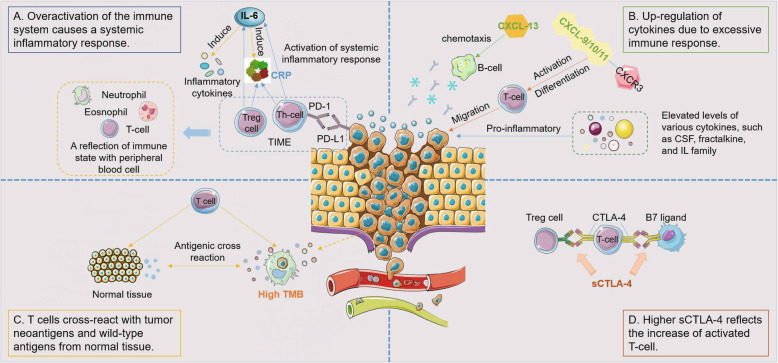Fig. 1.
Possible mechanisms of nonspecific biomarkers of irAEs. a Possible mechanisms of CRP, IL-6 and blood cell count. Tumor-promoting inflammation can cause overactivation of the immune system and trigger a systemic inflammatory response, leading to some non-specific irAEs. b Possible mechanisms of cytokines. CXCL9/10/11, involved in the establishment of CXCL9/10/11-CXCR3 axis in tumor microenvironment, is chemokine to activate T cells and regulate the differentiation, activation and migration of immune cells. CXCL 13 is the B-cell chemoattractant. Their upregulation is associated with a variety of autoimmune diseases, which is considered to be a key cytokine axis closely related to irAEs. And the increased expression of 11 cytokines represented by CSF, fractalkine, and IL family is closely related to severe irAEs. c Possible mechanisms of TMB. Dead tumor cells can released neoantigens which produce a high TMB. While fighting against neoantigens, T cells could also cross-react with the corresponding wild-type antigens in normal tissues, resulting in damage to normal tissues. d Possible mechanisms of sCTLA-4. Elevated levels of sCTLA-4 might block the interactions between full-length CTLA-4 expressed by autoreactive T cells and Tregs as well as B7 ligands, thus enhance the cytotoxicity of T cells and reduce the immunosuppression function of Treg cell. PD-1/L1, programmed cell death protein 1/ligand 1; TIME, tumor immune microenvironment; IL-6, interleukin 6; CRP, C reactive protein; Th cell, helper T cell; CSF, colony stimulating factor; TMB, tumor mutation burden; CTLA-4, cytotoxic T lymphocyte associated antigen-4; sCTLA-4, soluble cytotoxic T lymphocyte associated antigen-4

